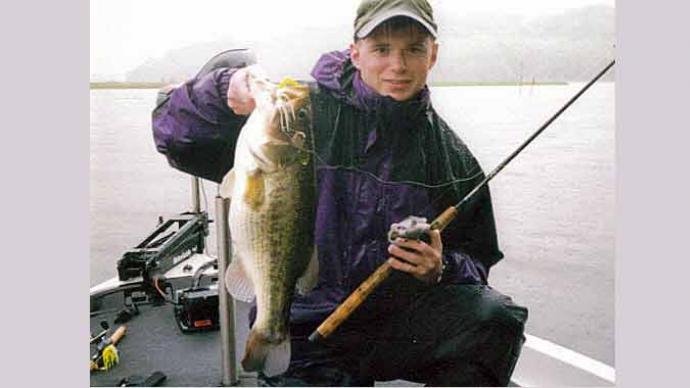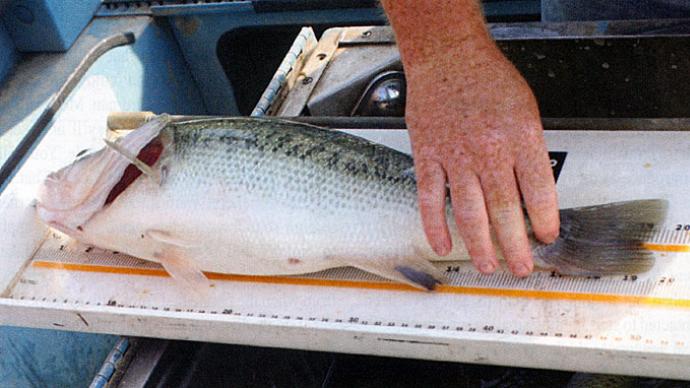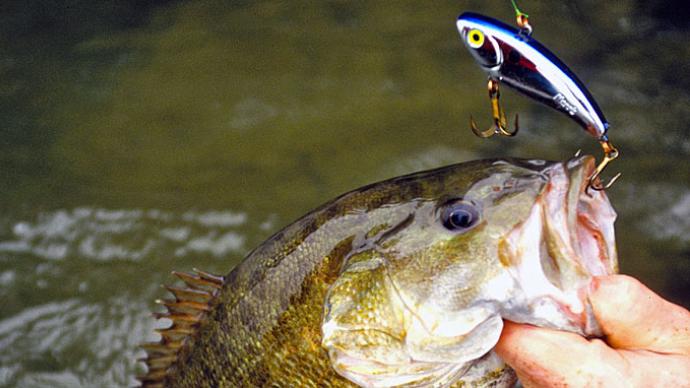
Dim red boat lights cast their faint glow on a gravel shore as Jack Daugherty and I sat perched on the rims of two five-gallon pails at his upstate New York property. It was midnight on a warm June night and we were exhausted and excited at the same time... sort of like expectant parents. In the distance, we could hear that faint, familiar droning hum of a generator on an electrofishing boat. The boat had been doing its job for about twenty minutes and when the vessel and its crew returned we would know exactly what fish swain these waters.
I was unconsciously wringing my hands in anticipation. Fish people do that.
Jack is a long-time Pond Boss friend and subscriber and these quarry pit lakes in New York were the subject of an earlier article (called The Opposite of Texas) in these pages. We were back at Jack's to do a more comprehensive fishery investigation. After all, the first "survey" had been done last year in July with a fishing pole. It was hardly scientific.
As we sat there in the dark, Jack and I talked about management of these waters. "Mark, do you think trout will do well in this pond" and "Do you think smallmouth will work out in here" and "What type of baitfish should we stock" were some of the questions we pondered. It seemed to me that the title of the first article was appropriate. Jack really has a passion for cooler-water fish compared to his warm-water fisheries in his home state of Texas.
Those who know Jack know about his "outside the box" thinking. He always wants to do something that people don't typically do.
The whine of the generator stopped, the boat made a circle and the lights shone up the lake toward our quiet shoreline conversation. The boat motored up and my crew hopped out. They were as excited as I have ever seen. "You should have seen the size of that pike we missed!" hollered Matt, the primary net man on the boat. "He was huge, way bigger than the ones we caught!" My heart leapt... that means they caught some pike!
We lit up the area with a portable light and unloaded the fish from the livewell to be identified, weighed and measured. Jack eased closer and closer to the fish in the dim light to see exactly what was happening. The sleepiness in us had temporarily vanished, replaced by a little dash of adrenaline. In came the fish... many more than we expected. Several pike ranging from 20-30 inches, largemouth bass from 12-20 inches, plate size pumpkinseed sunfish, bluegill, scads of yellow perch, bullheads, carp, golden shiners, fallfish and spot-tail shiner and even more surprises. Large 13-15"gizzard shad! Cool. I have never surveyed small New York state lakes with gizzard shad. Rivers? Yes, ponds and lakes? No.
We did four electro-fishing runs for over an hour of "on time" with the electrofishing boat to measure the "catch per unit effort", a scientific comparison to give us an idea just how many fish might be in the lake.
As the night continued to blend into morning, we continued our work.

The electrofishing boat was but one prong in a four point sampling attack we planned for these gravel-pit ponds. We also added gill nets, experimental fishing (with a pole) and divers to the survey. As we wrapped up the night-time sampling, we set gill nets, to be retrieved the next morning.
Then it was time to rest. It didn't take long to go to sleep.
The next morning, Jack showed up at the lake with doughnuts and a big smile, perking up the weary crew. They worked hard the previous night.
The guys retrieved the nets and Jack was there like copper on a penny. "Is there anything new?" he asked in anticipation. Out came a nice 18 inch brown trout. Eureka! "Boy, I am glad to see that trout there" and "That confirms that this place can hold and grow trout". Jack and I were pleased to see that fish.
We suspected each pond could hold trout because they are 20-30 feet deep and had good summer oxygen all the way to the bottom. Water is clear and this part of the planet typically has mild evening temperatures during summer.
Finding healthy trout was very important to our plan. Jack was also exceptionally happy to see smallmouth bass were already established and substantial amounts of baitfish were present in these ponds.
Surprisingly, the overall gill net catch was less than impressive. I intentionally set gill nets in deep water, offshore, to catch fish we could not sample with the electro-fishing boat. The boat can only reach fish in shallow water but the nets can be adapted to fish any depth.
I had set one to catch fish on the bottom in 20+ feet and one to fish the surface over deep water, offshore, to catch open water schooling baitfish. Electrofishing is not effective in open water because there is nothing to "trap" the fish against (like the shore or the bottom) and fish can simply swim away from the boat as it approaches. Setting an open-water gill net is the best way to look at these more pelagic or depth-oriented fish. The gill nets caught only five species of fish but did catch brown trout and white sucker, which the boat did not. That proved to be important to our decision-making.

The final part of this survey centered on divers or as I affectionately call them... "Frogmen". Luckily, these guys work for food. They can do something that the sampling gear cannot. These living sampling tools can characterize habitat for us and tell what the lake bottom is like, what the plants are like and how many fish they see. I wanted Jack to get a FEEL for the place by having someone describe all aspects of the habitat to him. Only a first hand account from a person can do this. We sent down two divers, each with two tanks of air and an arm tablet and a grease pencil to record what they saw. The divers observed seven species of fish, including one new one not caught by the gear ... a white crappie. Above all else, these guys gave us an accurate description of habitat. Because the lakes are old quarry pits, the bottom has zero structure and is a flat plain of fluffy stone dust. All fish observed lingered near weeds which were closest to the shore. These ponds need some deep water structure to hold fish. That point was as clear as the water.
Last, we broke out the fishing sticks and everyone fished... Jack, the divers, me, everybody. Five species of fish were caught including one 36" pike by Jack, and one new species not caught by the other gear ... a chain pickerel. Fishing was good with most fish coming on plastic worms fished in the weeds and sticks (structure) near shore. The best luck was had in the debris near an abandoned beaver lodge.
After doing a little research on the ponds and conferring with a New York State fisheries biologist, we realized the ponds have the same fish as a nearby creek that occasionally overflows its banks and spills into the ponds during extreme floods. The state DEC even stocks trout in this stream in the spring. These fish could easily migrate up the outlet of the pond as it spills into the creek. Very interesting facts to learn. This whole fishery was making perfect sense.
At a relaxed late breakfast that morning, Jack and I sat down and completed a New York State fishing preserve permit. In New York, this permit allows the owner or his representative to stock the pond, sample the populations and fish for them independent of most statewide regulations. In other words, I can go in there and net or electrofish when needed and Jack can fish when he wants to without violating the law. This will give us increased flexibility to manage his ponds. News Flash... Jack just called and the permit is in his hand.
Time to go to work!
I love my job.
Mark Cornwell is a fisheries professor at SUNY-Cobleskill in Cohleskill, New York. His passion is raising walleye and the I.Q. of fisheries students in the Northeast.
Reprinted with permission from Pond Boss Magazine



